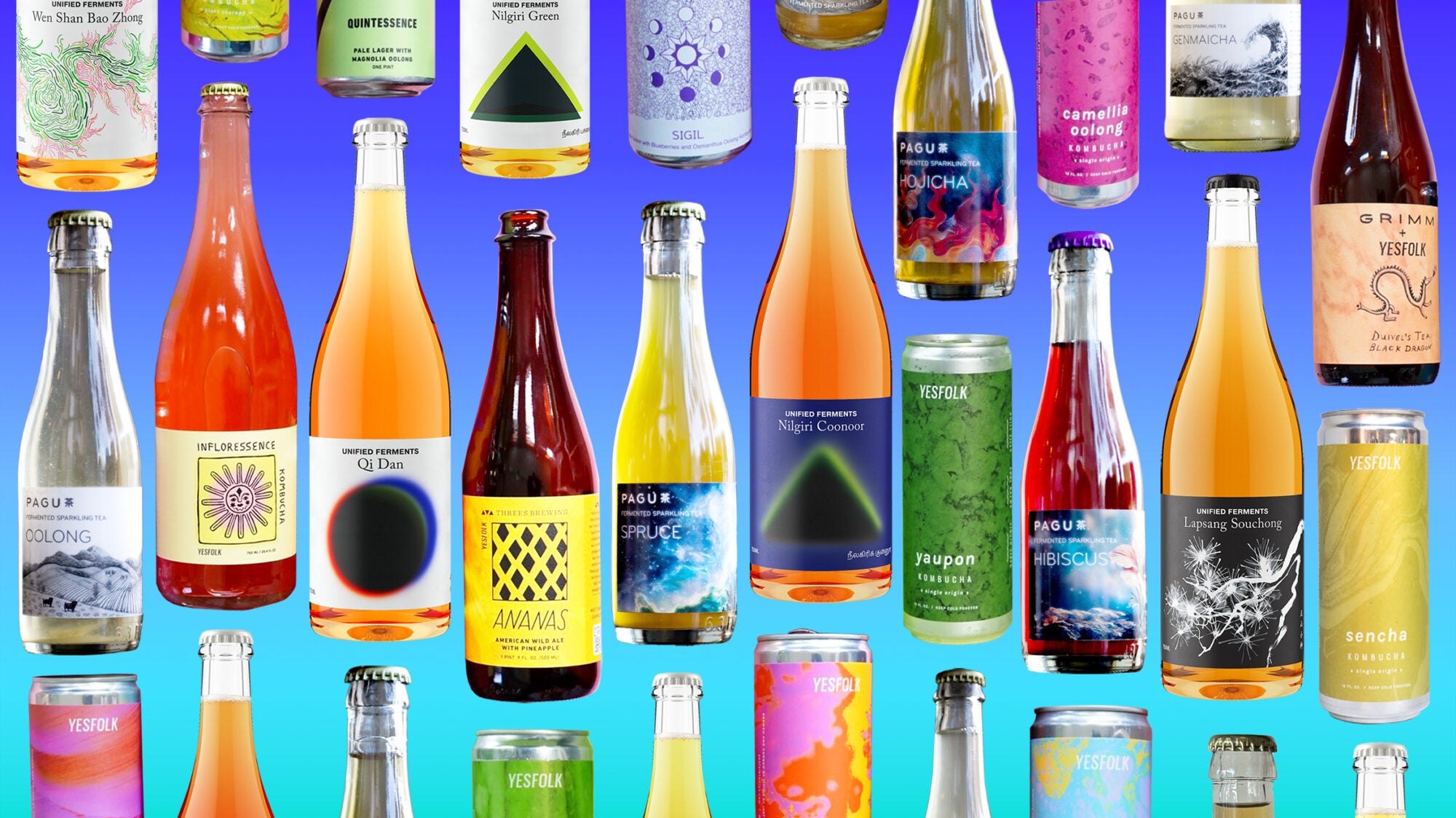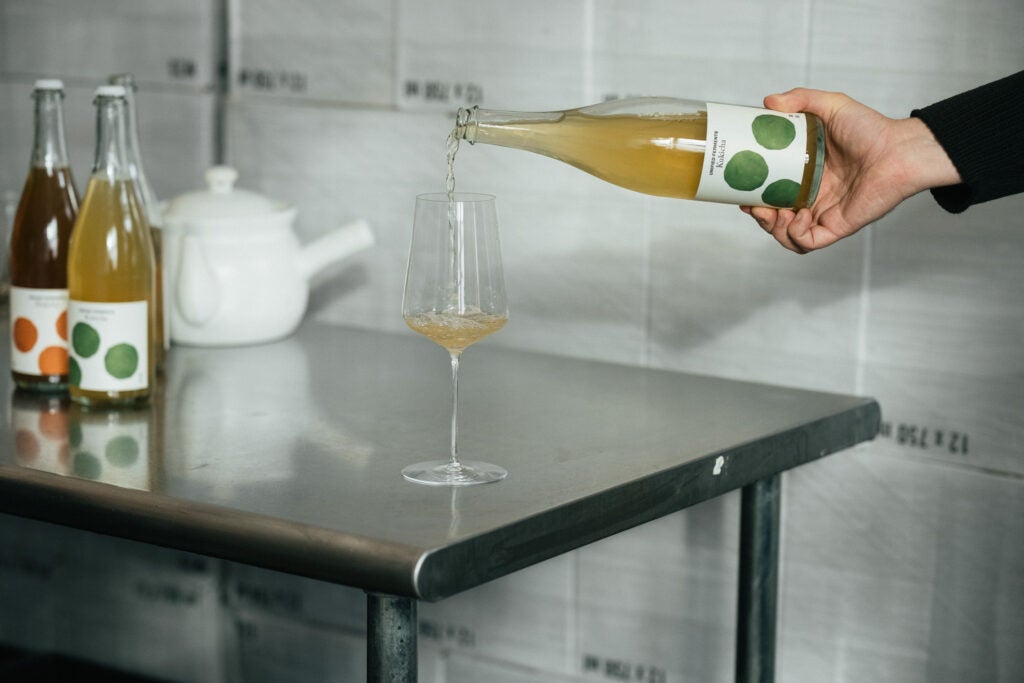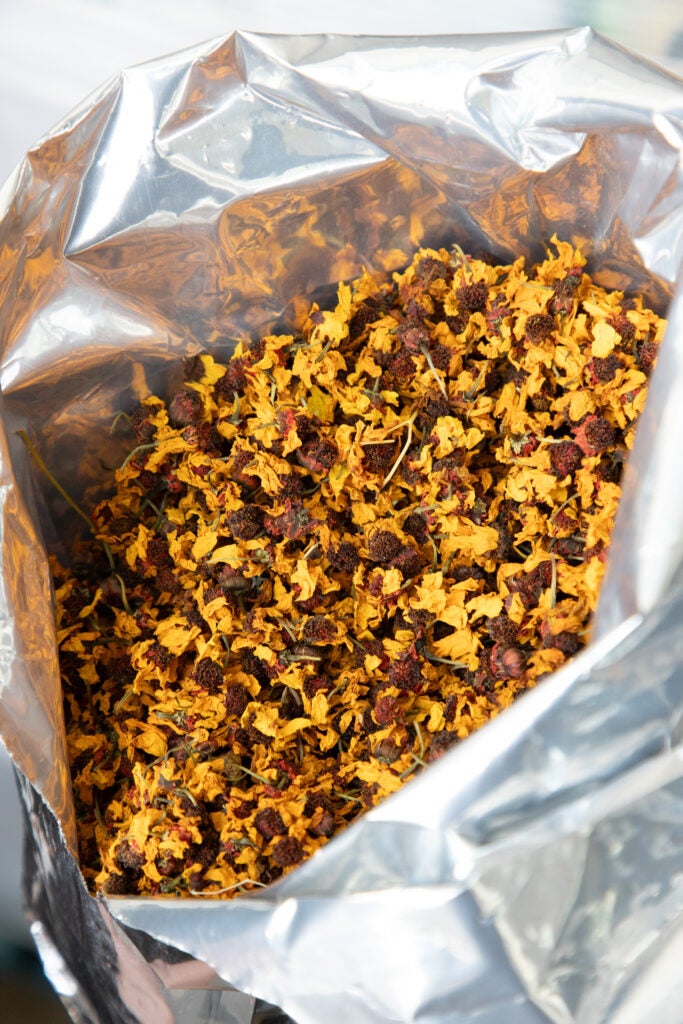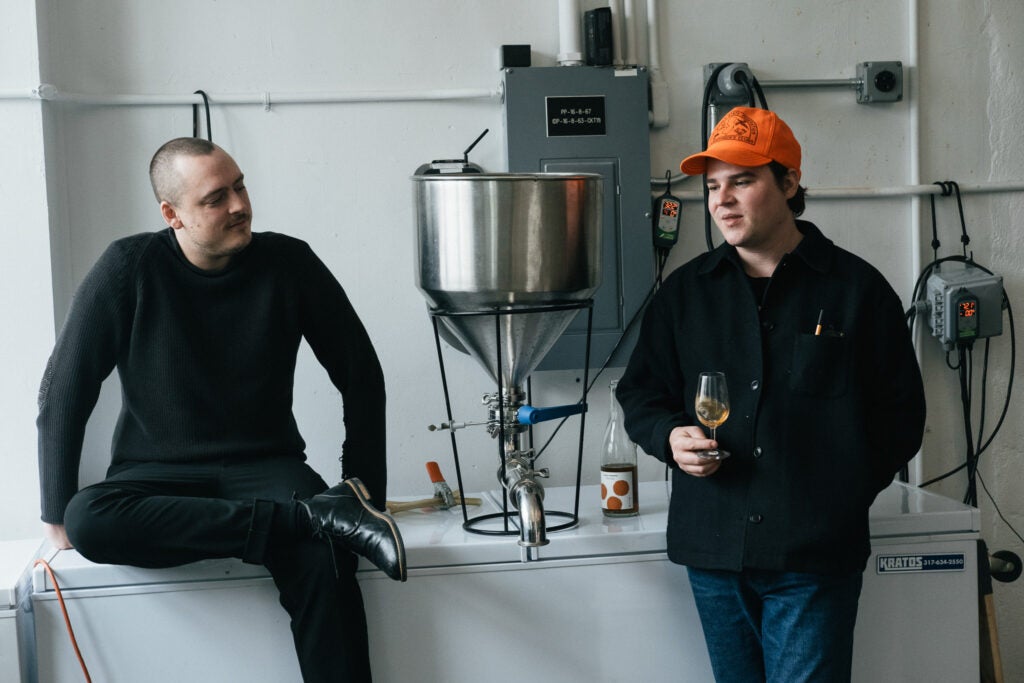
As nonalcoholic drinking crescendoes, kombucha leaves its hippie roots behind and is reimagined with refinement—and tea—at the center.
There’s no escaping kombucha’s friendly, fizzy face at the grocery store. Rainbow rows of bottles glow on the refrigerated shelf beside probiotic sodas and ginger shots, promising a bubbly boost for your gut. But for certain discerning beverage heads, the mere mention of the drink raises some eyebrows, likely due to kombucha’s reputation for cloying flavors and brands that lean a little too hard into the gut-health gospel.
So when Young Stowe and Graham Pirtle began approaching restaurants in 2019 with samples of their Snow Chrysanthemum—a floral, amber-tinged kombucha brewed with honey and flowers grown beneath China’s Kunlun Mountains—they were met with skepticism. “We would taste with the bar manager, who’d tell us, ‘Chef just doesn’t like kombucha,’” Stowe recalls of the initial pushback.
This pushback did little to deter them. Convinced there was room in the still-nascent nonalcoholic market for their products, which bucked convention by placing kombucha’s base ingredient, tea, in the spotlight, the duo kept refining. In January 2020, they launched Unified Ferments, a Brooklyn-based fermentation company with Snow Chrysanthemum as its first release. Their single-origin lineup has since expanded to Jasmine Green, Nilgiri Green, and Wen Shan Bao Zhong, each named after the tea it highlights.
“It’s kind of a no-brainer to put something as complex and beautiful as tea in a bottle,” Stowe remembers thinking. “Why is nobody doing this?”

Unified Ferments
Today their drinks, dressed up in sleek wine bottles and poured into stemware, appear on some of the country’s most respected beverage lists—everywhere from New York’s Eleven Madison Park and Brooklyn’s The Four Horsemen to Kato in Los Angeles—as sommeliers look to bring interesting NA offerings to their guests.
They’re not alone, either. Across the country and abroad, a new generation of brewers wants to shed kombucha’s old image as a health tonic spiked with raspberry lemonade or cola flavoring. Instead they’re pushing kombucha closer to the world of terroir-driven beverages, starting with tea, where sourcing matters just as much as flavor.
At its simplest, kombucha requires just three foundational ingredients: water, sugar, and tea. Fermentation begins when a gelatinous disk known as a SCOBY—a symbiotic culture of bacteria and yeasts—transforms the sweet liquid into a gently carbonated brew. (A SCOBY can be acquired from another kombucha brewer, or it can form spontaneously when unpasteurized, raw kombucha is added to sweet tea and left to ferment.) Many commercial brands lean heavily on whole fruit, fruit juice, and additives to cover up lackluster teas, but today’s producers want to shift the focus back to the historic plant.
Though tea has been cultivated and celebrated for millennia, the flavored kombucha as we know it is barely a few decades old. Kombucha’s exact origins are murky, but some scholars speculate it dates back to 221 BCE in Manchuria. Later, it evolved into drinks known as kōcha kinoko, or black tea mushroom, in Japan; golden tea in Korea; and chaynyy grib, or tea mushroom, in Russia. Just a few decades ago, one of the first commercial kombucha breweries, GT’s Living Foods, opened in Southern California in 1995. Then in the 2010s, buoyed by denim-clad hipsters and health-conscious marketing, commercial brands such as GT’s, Health-Ade, and PepsiCo-owned KeVita catapulted this category into a full-blown kombucha craze.
As kombucha’s popularity rose, so did opportunities to reimagine the mass-marketed drink and inform people about its flavor potential. Five hours north of Brooklyn, in Troy, New York, Yesfolk has emerged as one such kombucha destination placing tea at the forefront. Since opening in 2017, founders Yiyi Mendoza and Adam Elabd, a tea-obsessed couple who met while studying herbalism, have focused as much on education as on production. In their tasting room, on-draft kombucha flows alongside vintage bottles aged in oak barrels, some alcoholic versions made in collaboration with local breweries. Meanwhile, their core line of brightly labeled 12-ounce cans grace the aisles of gourmet grocery stores and coffee shops around the region.
“Typically, in cider, coffee, and beer, the source material is everything,” says Mendoza. “Whereas in kombucha, tea is rarely regarded.” Yesfolk’s single-origin series, featuring brews like bamboo oolong, Japanese sencha, and yaupon (North America’s only caffeinated plant), aims to change that. “It’s really about paring it down so you can let the tea shine,” she adds. “The personality of the tea is what you’re coming face-to-face with.”

Chrysanthemum tea at Unified Ferments
Restaurants are catching on, too. In Boston, Tracy Chang, chef-owner of Spanish Japanese tapas restaurant PAGU, never quite fell for kombucha’s acidified, saccharine flavors. But after fermenting teas such as genmaicha and Yunnan black tea and being astounded by the resulting drink’s complexity, she felt inclined to continue her experiments. “I liked how sparkling teas could be complex with five or six ingredients, or kept really simple.”
Today she brings her fizzy findings to the public through Spirited Away, a monthly workshop at the restaurant dedicated to nonalcoholic beverages. (As a fermented beverage, kombucha does contain trace amounts of alcohol, typically no more than 0.5% ABV, which keeps it legally nonalcoholic.) There she frames sparkling tea as a serious drink, worthy of pairing with restaurant food, and uses it to spark deeper discussions about global tea sourcing. “A third wave is overdue for tea,” she says. “People are asking: How do people source it? What classifies tea versus a tisane? Where does sparkling tea fit in?”
At Kato in Los Angeles, bar director Austin Hennelly similarly had initial hesitations about kombucha. But once he tried Unified Ferments and its effervescent fermented teas, he knew they would fit naturally into the restaurant’s beverage program. “More and more guests want alcohol-free beverages when they go out,” he says. “If a restaurant or bar doesn’t have the time to devote to alcohol-free cocktail programs but still wants to offer options—which they should—then sparkling teas are a great way to achieve that.”
Creating tea-forward kombucha presents its own challenges. For starters, thousands of tea cultivars exist around the world, but not every variety, even the most prized ones, will translate into compelling combinations. “Most teas actually don’t work,” Stowe admits. “Not everything wants to be acidified, fermented, and carbonated.”

Graham Pirtle and Young Stowe of Unified Ferments
Take Da Hong Pao, one of China’s most expensive and celebrated oolongs from the Fujian province. On its own, the tea produces a complex, slightly sweet, lingering aftertaste. But once fermented, the notes tend to clash instead of harmonize. Conversely, a more everyday cultivar like Wen Shan Bao Zhong, a lightly oxidized and mellow oolong tea commonly consumed in Taiwan, stretches and blooms into a web of orchid and honeysuckle notes when fermented.
As far as microbial research in this field goes, kombucha is still in its infancy. Curro Polo, a PhD student at Harvard and the Basque Culinary Center who studies microbiology and kombucha, puts it bluntly: “The wine and beer industries are so powerful because they invested a lot of money on research,” says Polo. “But that didn’t happen with kombucha. It was a drink that sort of tasted like vinegar that some people in Arizona would drink and be like, ‘Oh, this is magical.’”
At Ama Brewery in the Basque Country, where Polo conducts his graduate research, kombucha is once again undergoing a transformation. Since the beginning, Ama’s cofounders, Ramon Perisé and Dani Lasa, have preferred the label “pét-nat teas,” a term that borrows language from the natural wine world. “Let’s forget about the label ‘kombucha,’” Polo recalls them saying. “Think of it as a liquid, because a lot of complex things happen when you put something into a bottle.”
Back in Brooklyn, Stowe no longer feels beholden to kombucha’s rules. Similar to Ama, Unified Ferments has stepped away from labeling products as kombucha. Instead, Stowe prefers the term ‘fermented teas,’ a subtle but critical swap that signals both respect for the base ingredient and a departure from kombucha’s cloyingly sweet commercial flavors. “The industry hasn’t come up with good terms for these new things,” says Stowe. “We’re always playing against booze industry terms.”
These days, the team continues to tighten their production, engage with new collaborators (most recently with Japanese tea purveyor Kettl), and expand their vision of fermented tea to embrace kombucha lovers and skeptics alike—not only as a substitute for soda but as a serious, celebratory drink in its own right.
“We love it when people say, ‘I hate kombucha, but this doesn’t taste like it,’” says Stowe. “Well, we never wanted it to.”